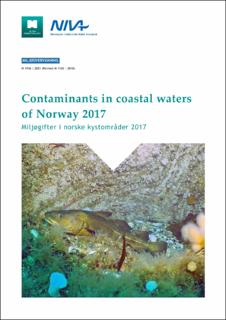Contaminants in coastal waters of Norway 2017
Green, Norman Whitaker; Schøyen, Merete; Hjermann, Dag Øystein; Øxnevad, Sigurd; Ruus, Anders; Lusher, Amy; Beylich, Bjørnar; Lund, Espen; Tveiten, Lise Ann; Håvardstun, Jarle; Jenssen, Marthe Torunn Solhaug; Ribeiro, Anne Luise; Bæk, Kine
Research report
Published version
Permanent lenke
http://hdl.handle.net/11250/2588674Utgivelsesdato
2021Metadata
Vis full innførselSamlinger
- NIVA-rapporter [7006]
- Publikasjoner fra Cristin - NIVA [2160]
Sammendrag
This programme examines the levels, trends and effects of contaminants in biota along the coast of Norway. The 2017-investigation included analyses of 93 different contaminants or biological effect parameters in five species (blue mussel, dogwhelk, common periwinkle, cod and the common eider). The contaminants include metals (Hg, Cd, Pb, Cu, Zn, Ag, As, Ni, Cr and Co), tributyltin (TBT), organochlorines (e.g. PCBs, DDT), PAHs, polybrominated diphenyl ethers (PBDEs), perfluorinated alkylated substances (PFAS) as well as contaminants that have recently received much attention such as hexabromocyclododecane (HBCDs), chlorinated paraffins (SCCP, MCCP), bisphenol A (BPA), tetrabrombisphenol A (TBBPA), alkyphenols and siloxanes. Biological effects parameters included VDSI, OH-pyrene metabolites, ALA-D and EROD. In the report, 30 representative substances or parameters were chosen for analyses of 809 time series (last 10 years). Of these there were statistically significant trends in 193 cases: 83 were downwards and 35 upwards. The dominance of downward trends indicated that contamination is decreasing for the measured substances. The downwards trends for TBT-concentrations and effect parameter (VDSI) confirmed that the legislation banning the use of TBT has been effective. Of the 2017-medians (last year) for all 809 time series, there were 262 cases that could be classified against EQS, of which 157 (59.9 %) were below the EQS and 105 (40.1 %) were above the EQS. All of the 2017-medians from the 809 time series could be classified using a provisional high reference concentrations (PROREF). Of these 578 were below PROREF and 231 exceeded PROREF: 148 by a factor of less than two, 61 by a factor between two and five, 13 by a factor between five and 10, seven by a factor between 10 and 20, and two by a factor greater than 20. Some cases warrant special concern, such as high concentrations of several organic contaminants in cod liver from the Inner Oslofjord. High concentrations of DDE in mussels from the Sørfjord were related to earlier use of DDT as pesticide in orchards along the fjord. The influence of fish length on contaminant concentration was examined. Results of analyses of stable isotopes of carbon and nitrogen are presented to investigate the role of food origin and trophic levels for observed contaminant concentrations. In addition microplastics were investigated in blue mussel collected in 2016 and 2017.
Beskrivelse
Revised version of 7302-2018 / M-1120
Serie
NIVA-rapport;7580Miljødirektoratet-rapport;1936
